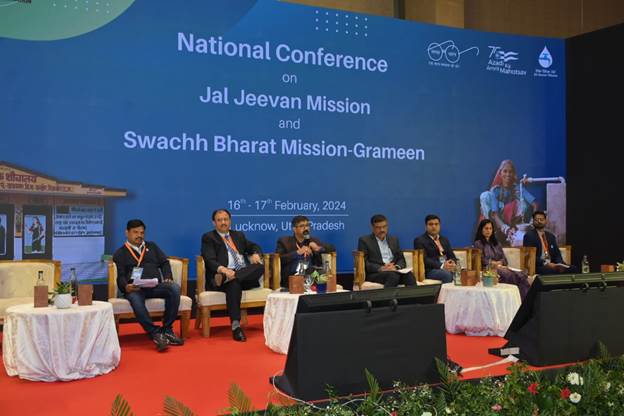The two-day National Conference on Jal Jeevan Mission (JJM) held in Lucknow, Uttar Pradesh, echoed the aspirations of millions. Over 14.33 crore rural households now enjoy the luxury of tap water, a testament to the mission’s impact. But for JJM, this is just the beginning. The conference served as a crucial platform to celebrate achievements and chart a course for a sustainable future, ensuring every rural Indian has access to clean, safe drinking water.
 The critical conversation revolved around source sustainability, the bedrock of long-term success. States like Arunachal Pradesh, achieving 100% coverage, demonstrated the power of effective implementation. However, concerns regarding operation and maintenance (O&M) remained a hurdle. The conference emphasised the need for tailored policies and capacity-building initiatives to bridge this gap, ensuring infrastructure longevity and optimal water management.
The critical conversation revolved around source sustainability, the bedrock of long-term success. States like Arunachal Pradesh, achieving 100% coverage, demonstrated the power of effective implementation. However, concerns regarding operation and maintenance (O&M) remained a hurdle. The conference emphasised the need for tailored policies and capacity-building initiatives to bridge this gap, ensuring infrastructure longevity and optimal water management.
JJM recognises that true sustainability hinges on community ownership. The Nal Jal Mitra Programme (NJMP) and Recognition of Prior Learning (RPL) emerged as promising avenues for skilling manpower locally. Jharkhand’s story, where Jal Sahiyas, trained women water quality testers, and spearheaded a women-led movement, exemplifies the power of community engagement. Nalina, a beneficiary from Karnataka, shared her village’s transformation – reduced water scarcity, improved school attendance, and minimized water-borne diseases, highlighting the tangible impact of community-driven initiatives.
The conference acknowledged the crucial role of citizen feedback and grievance redressal mechanisms in ensuring JJM’s long-term success. Tripura’s multi-skilling local communities under NJMP serve as a model for integrating community concerns into solutions. Water quality remained a top priority, with discussions around SOPs emphasizing the need for well-monitored disinfection systems and exploring cost-effective methods.
While the 14.33 crore figure paints a promising picture, the conference served as a reminder that the journey is far from over. Last-mile connectivity remains challenging, and achieving JJM’s objectives requires sustained efforts. States like Mizoram’s Village Sailam, a model for sustainable Har Ghar Jal, offer inspiration for the path ahead. The conference emphasised the importance of continued collaboration between the central government and states, leveraging technology and best practices to ensure sustainable water management.
JJM is not just about numbers; it’s about transforming lives. The conference served as a powerful reminder that the mission’s success hinges on addressing O&M challenges, empowering communities, and ensuring water quality. By adopting innovative approaches, fostering community engagement, and prioritizing sustainability, JJM can spark a revolution in rural India, paving the way for a future where clean, safe, and accessible drinking water is a reality for all.




